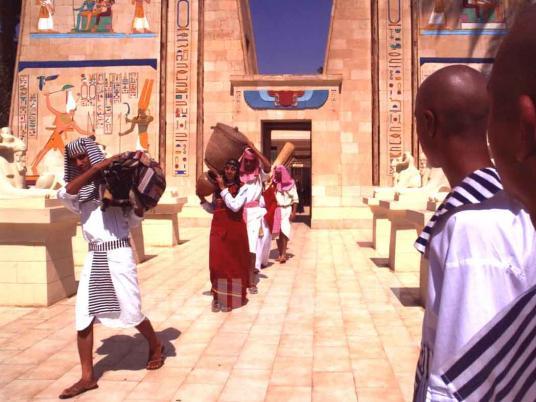A flipside to the honor of having something named after you is the unintended negative connotations it might later bring. So, it should be clarified that while Egyptian writer and poet Abbas al-Akkad was known for many things, a fondness for prostitutes wasn’t one of them.
“What is this street known for?” A young pedestrian repeats Al-Masry Al-Youm’s query before offering the third consecutively identical answer. “Prostitutes,” he smiles hollowly. “It’s known for prostitutes.”
This was the typical answer among the young men we questioned on a characteristically chaotic Thursday evening. But other visitors to Abbas al-Akkad street may offer different answers. Balancing his infant daughter over his left shoulder, 38-year-old Ibrahim Haggag has a more wholesome evening in mind. Standing outside an ice-cream parlor with his wife and two children, Haggag recounts the night’s events, from dinner to shoe-shopping for the kids to ice-cream. “We also need to buy a new vacuum cleaner,” he adds, gesturing down the road where numerous appliance stores await.
Abbas al-Akkad street is for all intents and purposes the backbone of Nasr City, and the event horizon to the district’s black hole, in that escaping it seems almost impossible. Perpetually congested, the street pulls you in, and is an unavoidable destination given its central location in a grid-like layout. It has an endlessly wide variety of shops, sidewalk spreads, cafes, and fast food joints. Like an imploded mall steamrollered into a long strip, Abbas al-Akkad is the place to go if indoor malls strike you as too confined, especially if your sense of fashion can be best described as an affinity for glitter.
For all its variety, the merchandise available in Abbas al-Akkad’s innumerable establishments seem to share one common feature–eye-watering gaudiness. From sequined veils to tasseled fluorescent lingerie, knock-off brands to unlabelled appliances, gold-leaf furniture to pleather office sets, Abbas al-Akkad has everything you could possibly want if tackiness is your prerequisite.
Nasr City itself is a relatively young district. As any long-term resident will proudly inform you, less than 30 years ago this was all desert and sand dunes. "There was nothing out here but the occasional military base or outpost,” says 42-year-old Ashraf Mostafa, who counts his family among the pioneers who first settled the then-remote area. With an apartment directly across from one of the street’s busiest cafes, Mostafa fondly recalls those early, quiet days, now long gone.
“I used to stay up on our balcony all night, watching the planes go by. I loved everything about them–the way they looked coming out of the clouds, the sounds they made,” says a nostalgic Mostafa, who as a child had dreams of growing up to become a pilot. Nowadays, he points out that the planes can’t be heard over the constant din of traffic. “Back then it was just us, a couple of other buildings, and the airplanes.”
“Me and my sisters weren’t allowed to go out after dark,” says Amany Hakim, 37. Growing up on Abbas al-Akkad, Hakim has spent most of her life in Nasr City. When she married, she and her husband moved into an apartment a few blocks away from her childhood home. Remembering the days before Nasr City was a beacon of neon lights and tawdry window displays, Hakim has a hard time believing how rapidly–and messily–her neighborhood has grown. “It’s funny that, even though it’s supposedly developed now, I still won’t let my own daughters out alone after dark.”
It’s hard to accuse Hakim of being overprotective–a brief Thursday night stroll reveals an alarming rate of blatant sexual harassment directed towards most girls brave enough to venture out without adult supervision. While the street may not be crawling with clearly identifiable prostitutes, its sidewalks are heavily populated by roaming packs of salivating young men who confidently recognise any girls unaccompanied by parents.
“Yeah, that kind of harassment happens a lot,” says Ahmed Ibrahim, a 27-year-old who sells boxers and socks on a stretch of the street’s sidewalk. “But what are you going to do about it?” Ibrahim claims he’s too busy worrying about other things to worry about girls who “choose to go out alone.” Ibrahim’s main concern is police officers, who routinely come by to confiscate his merchandise because he has no permit to be selling items of any kind on the sidewalk. “It’s ridiculous, I don’t bother anyone. If people want to buy my stuff, they do, but I don’t hassle pedestrians.” In response to Al-Masry Al-Youm’s gently-put suggestion that the officers' actions may be an attempt to give the street an appealing appearance, Ibrahim sarcastically spits, “yeah, because it’s so beautiful.”
“The only difference between me and the people selling the same stuff in those shops,” he bitterly explains, gesturing vaguely down the street, “is that they’re indoors, and I’m out here.” Ibrahim may be missing the point entirely, but one could argue the same of the officers insisting on removing him and the other sidewalk vendors. True, Abbas al-Akkad Street isn’t an open marketplace, but then again, neither is it the exclusive strip of prestigious establishments and high-end brand names many of its misguided patrons seem to think it is. In the end, it’s a busy, cluttered strip of excessive light and noise where, in terms of aesthetics, pretty much anything goes–in other words, a quintessential embodiment of the spirit of Cairo, prostitutes and all.
Our latest series involves profiling the streets and districts of Cairo. An old and beautiful city, those of us living here often overlook the history and life of the streets we rush through on our way to work or the crowds we curse at when Cairo traffic stands still. Divided years ago by craft, class or religion, the districts and streets of Cairo still hold much of their original identity and are often still referred to by their original inhabitants. Every Saturday Al-Masry Al-Youm will bring you a different street or district of Cairo–stay tuned!


